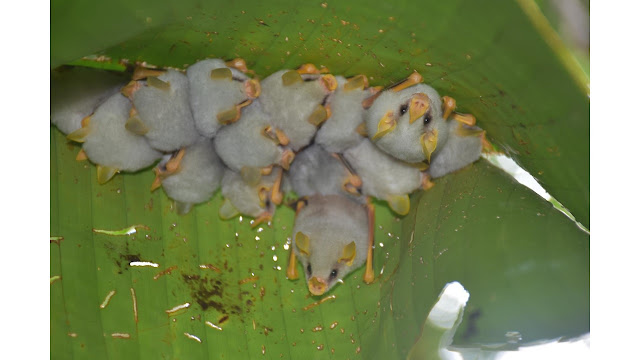Here's the swinging bridge.
Here's the view up the river. You can see the early morning mist.
On the trip, a lot of students get up early (6:00) to join Tim Parshall and Debra for birding. Here, Tim, Debra, and Heather check out some local birds.
Here are a lot of hungry WSU students chowing down in the dining area. Breakfast is at 7:00. There are about 150 guests at the research station, with a lot of college trips. We've seen students from Keene State, Michigan State, Colgate, Hobart Smith, and other schools. There are also a lot of scientists, graduate students, and researchers at the research station, carrying out tropical research.
The schedule is very packed, so you have to grab a moment when you can. Here, Bridget writes in her journal. The journal is a critical component of the trip, and there is SO MUCH going on and you see SO MUCH that keeping your journal up to date in the limited free time is a real chore.
Bekah checks in with her family and friends.
Kate, Paige, and Chloe enjoy the last cuppa before work starts.
Tim watches as Nick nabs a spider to inspect it.
Here's John, chatting on the sofa.
And Charlie.
Right outside the cafeteria is a tree with this beautiful Orchid. My wife allowed me to go on this trip only if I took pictures of Orchids, so here it is :-) I think she said this one was a Brassavola species. I feel kinda guilty. As I write this in short sleeves, sweating, she says the temperatures at home, with the wind chill are -40 F.
Many of the birds and mammals are high in the trees. So guides use spotting scopes, which are more powerful than binoculars, to bring the animals into view for folks to see. Here, Coltin checks out a bird.
Heather gives a bird "the eye."
Nick is excited by what he sees.
Albert, our local guide, explains some of the intricacies of the forest.
The group crossing the swinging bridge.
The tale-tell sign of a guide is a heavy tripod with a spotting scope, and they're always looking up.
It always amazes me how much activity goes on at one time. People looking through the scope, through binoculars, looking things up in books, checking web resources, thinking, explaining, asking...
This is a picture of the soccer field, with the forest in the background. You can get a sense of the size of some of the plants.
I think this is a three-toed sloth.
There's no end to the diversity of birds. In Costa Rica, you have migrating birds from North America, South America, Central America, and native birds. Many of the bird species are elevation dependent, and dependent on the wide variety of forest ecosystem types. Tim Parshall and Deb are both quite good at spotting and identifying them. On one two-week trip, Tim saw and identified 174 birds. Me, I'm not so good at it. Plus, as you can imagine, they're wicked hard to photograph high in the trees.
Here Chloe, Deb, and Tim walk on the trail. Deb is explaining some bird concept to Chloe. Notice that both Deb and Tim have their bird ID books in hand. Identifying what you see and trying to understand its role in the ecosystem is a never ending task.
This is a long-nosed bat.
Q: How many white tent bats do you see? These bats work as a team to chew through the veins supporting large leafs till the leaf folds over, making a tent the bats use as shelter. As their food source is used up (fruits), they move along to a new location that has ripe fruit and create a new tent. Each of these little balls is about the size of a ping pong ball, or a little smaller.
A: 14
I get a kick out of these Toucans - just like on the cereal box. Their beaks are so large, its hard to understand how they can fly.
A weeny tiny lizard, about an inch and a quarter long.
In the afternoon, we went a a chocolate tour. I'll post something on that in the morning.


































No comments:
Post a Comment